
What is that mold in my forage?
Molds are a diverse group of microscopic fungal species that break down natural materials. The formation of molds often occurs in the field prior to harvest or during storage. It is dependent on environmental weather conditions including temperature, moisture content, oxygen levels, pH, substrate and other stressors like physical damage to the crop.
Molds require moisture and oxygen for growth and derive energy from the organic matter on which they live. The presence of mold on grains and feed ingredients has been shown to negatively impact the nutritive value, impacting energy, vitamin, and amino acid digestibility. Mold also can reduce feed palatability. Certain types of molds pose an additional significant risk through production of secondary toxic metabolites known as mycotoxins that can negatively impact animal health, performance and reproduction.
Three key genera of molds are known to produce mycotoxins, including Fusarium (field-associated) as well as Aspergillus and Penicillium (storage-associated).
Preventing mold growth and subsequent risk of mycotoxin formation is difficult, especially since some key factors are out of human control. However, if visible mold is present, some indicators may help in identifying the type of mold and the potential risk for mycotoxin contamination. One thing to keep in mind is that visible mold growth on feed does not guarantee the presence of mycotoxins, but it does indicate increased risk for contamination and can reduce feed quality and palatability even if toxins do not exist.
Additionally, visual inspection may miss some mold growth since it is often very unevenly distributed and may not be exposed or seen. Since mycotoxins are stable compounds that are not living, they may have been produced in the original forage material when the mold was living, but the mold has since died off and no longer exists. Relying only on visual mold presence as an indicator of mycotoxin contamination is not recommended.
Common mycotoxin-producing molds to look for in forages include:
Fusarium spp.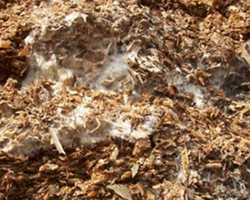
- White mycelium potentially producing pink or purple color
- Major occurrence: corn, grass and grain silage
- Mycotoxins and possible effects:
- Trichothecenes (e.g., Deoxynivalenol and T-2 toxin): Digestive disorders; bloody feces; feed refusal; reduced weight gain; hemorrhagic rumenitis; immune modulation; increased inflammatory reactions; mastitis; laminitis; decreased milk production
- Zearalenone: Estrogenic effects; edema of vulva; atrophy of ovaries; swelling of the mammary gland; decreased milk production; reproduction problems; decreased conception rate; reduced testicle size; infertility; abortion
- Fumonisins: Liver and kidney damage; immune modulation
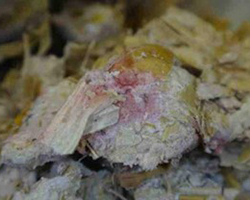 Monascus ruber
Monascus ruber
- White mycelium with yellow-orange to mostly red color when mature
- Major occurrence: corn silage
- Mycotoxins and possible effects:
- Monacolin: Suspected effect on rumen microflora (reduced fiber digestion)
- Citrinin: Nephrotoxic (causing kidney damage); teratogenic (causing damage to developing embryo/fetus); hepatotoxic (causing liver damage); immunosuppression (inhibitor of lymphocyte proliferation)
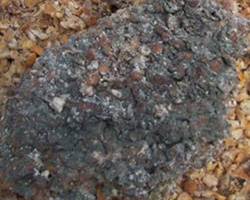 Penicillium spp.
Penicillium spp.
- White mycelium, green-blue to dark gray when producing spores
- Major occurrence: corn, grass, and grain silage
- Mycotoxins and possible effects:
- Ochratoxins: Nephrotoxic; carcinogenic (potentially causing cancer); mild liver damage; enteritis; teratogenic effects; poor feed conversion; reduced growth rate; immune modulation
- Patulin: Immune suppression; inhibition of rumen microbiota; reduced rumen fermentation; cytotoxicity (damaging cells)
- Citrinin: Nephrotoxic; teratogenic; hepatotoxic; immunosuppression (inhibitor of lymphocytes proliferation)
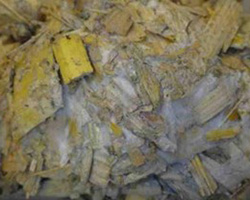 Penicillium roqueforti
Penicillium roqueforti
- White mycelium with blue-green to green color when producing spores
- Major occurrence: corn, grass and grain silage
- Mycotoxins and possible effects:
- PR toxin: Intestinal irritation; abortion; reduced fertility; degenerative effects on liver and kidneys; carcinogenic
- Patulin: Immune suppression; inhibition of rumen microbiota; reduced rumen fermentation; cytotoxicity
- Roquefortine C: Weak neurotoxicity; abortion; retained placenta
- Mycophenolic acid: Immune suppression, mild cytotoxicity (enhanced negative effects on intestinal cells when co-occurring with Roquefortine C)
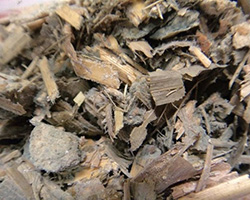 Aspergillus fumigatus
Aspergillus fumigatus
- White mycelium with cream to bluish-grey to dark brown color when producing spores, but some types remain white
- Major occurrence: corn, grass, and grain silage
- Mycotoxin and possible effects:
- Gliotoxin: Immune suppression; pulmonary mycosis (lung infection); abortion; mastitis
- Tryptoquivaline: Antibacterial effects affecting rumen fermentation
- Trypacidin: Poses pulmonary mycosis health risk to people – avoid spore inhalation
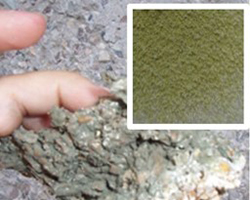 Aspergillus flavus
Aspergillus flavus
- Dried-out areas, white mycelium, spore production is usually yellow-green to dark green but can be white
- Major occurrence: corn silage
- Mycotoxins and possible effects:
- Aflatoxins: Liver diseases; carcinogenic effects; hemorrhages (intestinal tract, kidneys); reduced growth rate; reduced performance; immune suppression; transferred into the milk (AFM1); reduced milk production
- Cyclopiazonic acid: Necrotic effects (liver, gastrointestinal tissue, kidneys, skeletal muscles); carcinogenic (pathological changes in spleen); neurotoxic; potential immune suppression
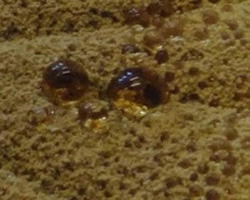 Aspergillus ochraceus
Aspergillus ochraceus
- White mycelium, spore production is chalky yellow to pale yellow-brown color
- Major occurrence: corn, grass, and grain silage
- Mycotoxins¬ and possible effects:
- Ochratoxins: Nephrotoxic; carcinogenic; mild liver damage; enteritis; teratogenic effects; poor feed conversion; reduced growth rate; immune modulation
Ensiled forages (haylages, silages, etc.) are common forages to see visual mold growth. This can be attributed to poor silage management practices, including improper moisture content at harvest, inadequate packing density, and poor feedout practices, which increase the risk of storage molds and mycotoxins. Aerobic instability creates an environment suitable for mold growth. Increased levels of oxygen – whether due to poor compaction, exposure from poor sealing of the silo or inefficient feedout – support storage mold growth and potential further contamination.
Ideally, implementing proper forage harvest and storage practices are key steps in reducing the prevalence of mold growth. However, even with good practices in place, it is difficult to eliminate mold growth completely. If visual mold is present or mycotoxin contamination is of concern, it is recommended to proactively analyze representative feed samples for nutritive value and mycotoxin contamination through feedout to help better understand what mitigation strategies can be implemented to limit negative effects associated with mold or mycotoxins.
| Category: |
Feed quality and nutrition Forage Foundations Forage harvesting Forage storage and management Silages |

